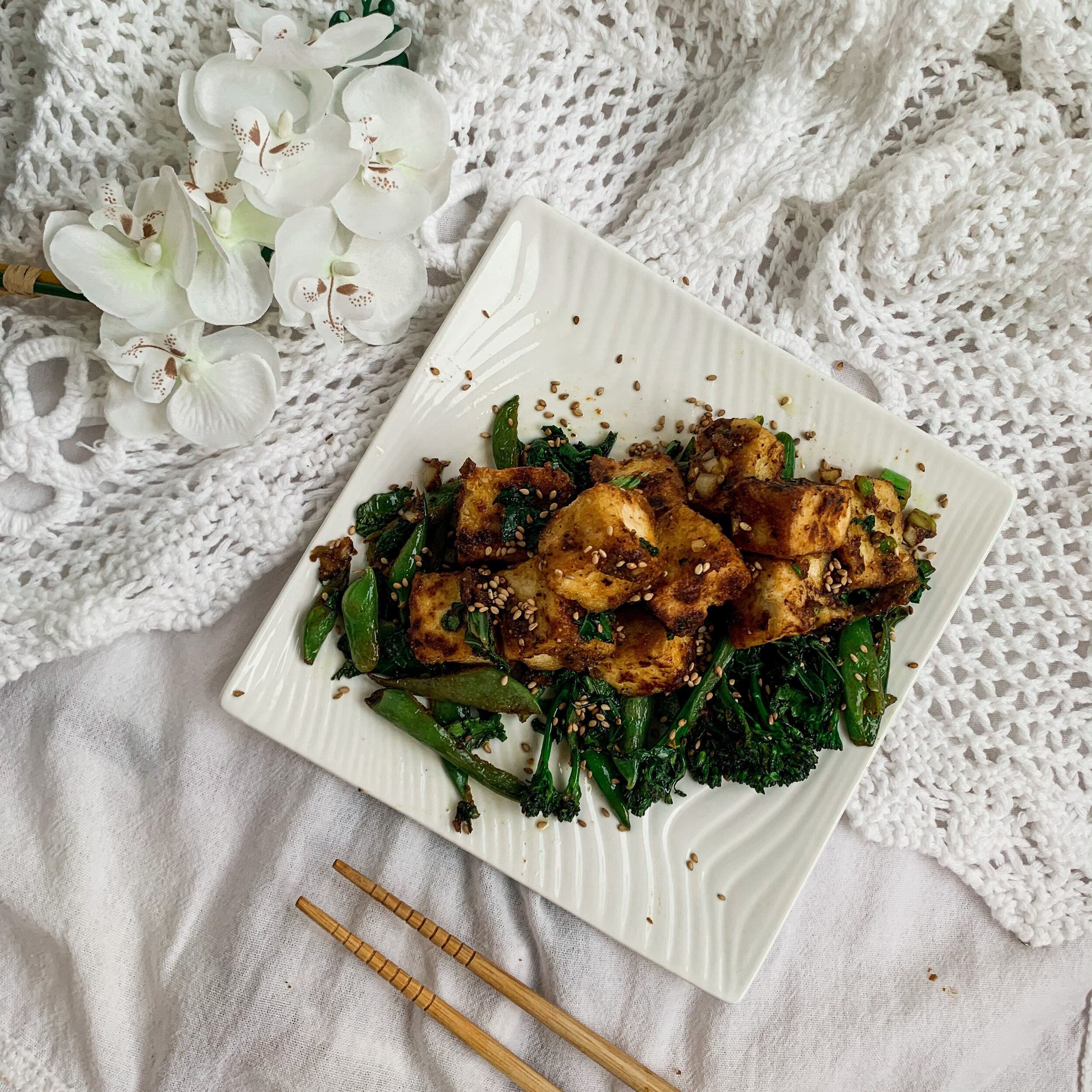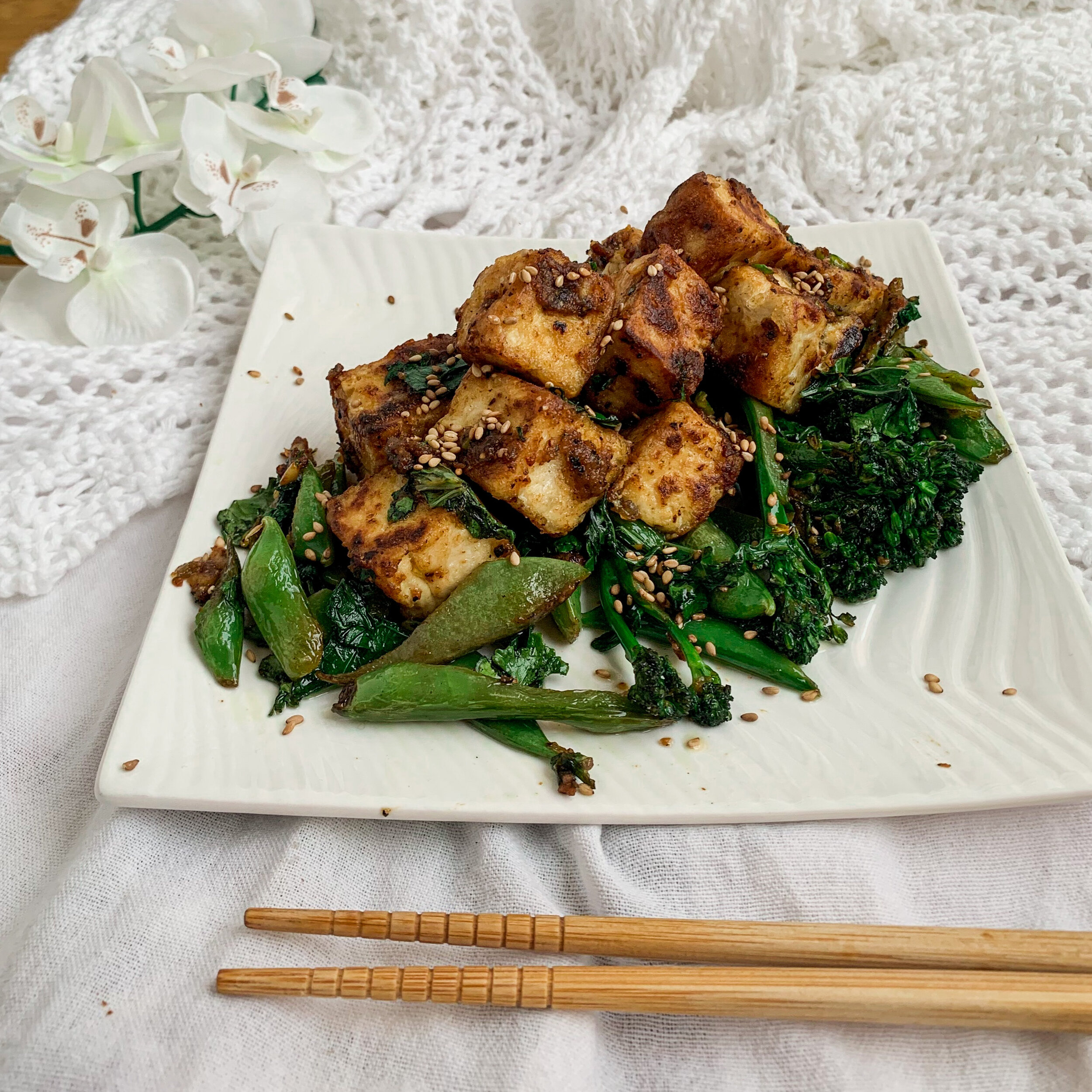miso brown butter X black pepper tofu
salty. sweet. nutty. peppery. crispy. (you name it, this vegan tofu dish has it.)
Servings: 2-3
(Active) Time: 45 minutes
Ingredients:
1 17-oz block of firm tofu
~2 tbsp cornstarch
neutral oil
3-4 tbsp vegan butter (3 tbsp if vegetable oil based, 4 tbsp if coconut oil based; see Recipe Test #4)
2 tbsp white miso
½-1 tbsp black pepper, freshly ground (see Recipe Test #2)
4 cloves of garlic, minced
1 inch knob of ginger, grated
2 handfuls of alliums of choice (white onions, yellow onions, shallots, etc.)
1 tbsp white sugar
4-5 handfuls of a mix of tougher and more tender greens (broccolini, asparagus, bok choy, sugar peas, spinach, kale, etc.)
2 tsp rice wine vinegar
serve with: white or brown rice or hearty grain of choice (e.g., farro)
Recipe:
1. Press tofu for at least 30 minutes.
To press tofu: Place tofu in between two plates with a heavy object on top of top plate.
2. Drain water from tofu. Cut tofu into 1-inch cubes.
Cut tofu “hamburger style” first. Then cut the sliced block into quarters and then sixteenths. You’ll get 32 1-inch squares.
3. Generously coat tofu cubes in cornstarch on all sides.
4. On medium heat, add neutral oil. Once oil is glossy, add tofu to pan.
In order to get crispy sides, do not touch tofu while it is frying on its first side (~4 minutes). Once golden on the first side, flip tofu. Continue flipping until all sides are golden. As the amount of oil decreases in the pan and the pan gets hotter, you will find that each consecutive side will brown faster (i.e., you will not need to wait 4 minutes per side but perhaps just a couple minutes per side). Lower heat as needed. Do not stray away from the pan.
5. Once tofu is golden on all sides, remove from pan and set aside.
6. On low heat, add the compound butter into the same pan.
In small bowl, mix together vegan butter and white miso until homogenized into a compound butter.
7. If you are using a vegetable oil based vegan butter, melt butter completely on low heat.
If you are using dairy butter or a coconut and cashew based vegan butter, brown the butter.
To brown butter: On low heat, the butter will froth. After the butter has completed frothing, the butter has browned.
8. Add black pepper. Heat for 1-2 minutes. At this point, the pan should become aromatic. (Do not burn the pepper. Burnt pepper will taste bitter.)
9. Add alliums (onions & garlic), ginger, and sugar. Cook until almost translucent.
10. Add tougher greens (e.g, broccolini, asparagus, bok choy, sugar peas, etc.). Cook until tender.
11. Add tender greens (e.g., kale, spinach, peas, etc.). Cook for 1 minute.
12. Add rice wine vinegar to deglaze pan.
To deglaze the pan: use the vinegar to loosen any dark or caramelized bits stuck to the pan into the sauce.
13. Turn off and take off heat. Mix crispy tofu into the pan until just evenly coated.
Do not overmix. If overmixed, crispy tofu will become soggy.
14. Serve immediately for crispiest tofu. Garnish with scallions and/or sesame seeds. Voila—fermented beans x2 and greens!
Non-negotiables:
Miso, obviously. It’s in the name of the dish. Miso is only source of salt in the dish. It also gives the sauce an irreplaceable nuttiness.
Freshly ground black pepper. None of that pre-ground stuff.
Try experimenting with:
Vegan butter - You’ll see in tests #3 and #4 that I experimented with Miyokos and Earth Balance, respectively. I wanted to test which two of the most popular vegan butters preserved flavor and sauteed vegetables better. The two are made from vastly different compositions. Miyokos is a cultured cashew and coconut blend while Earth Balance is a vegetable oil blend. Because vegetable oils have a higher smoke point, Earth Balance theoretically should work better over the stove. In tests #3 and #4, I found pros and cons to both. Miyokos preserved more of a buttery flavor. Miyokos also browns, adding to the miso’s nuttiness but also evaporating much of the initial liquid (i.e., water content). Earth Balance offered a saucier coating on all the vegetables, but the sauce was greasier. I preferred Miyokos, but Earth Balance or any other vegetable-oil blend is not a deal-breaker.
Greens - You’ll read in the tests that I tried a variety of vegetables. Pick any pairing of hearty and tender greens that is in season!
If you must, you can substitute cornstarch for white/brown rice flour. Rice flour does burn more easily though. But I would advise entirely against AP flour. For the crispiest tofu, you’ll want a flour that has a high starch:protein ratio. During cooking, starch wards off water while protein holds onto water.
Recipe Development:
Test #0: Before the fall of B*n App*t*t (and in my third phase of quarantine), I tried a BA Healthyish “Black Pepper Tofu and Asparagus” recipe by Sarah Jampel. I was attracted to the recipe because the recipe uses all pantry ingredients. True to its name, the recipe also only uses black peppercorns as its source of spiciness—no fresh or dried chiles.
What I did right: spice level, followed simple recipe with no subs
Needs Improvement: Too much soy sauce. The crispy tofu went soggy after mixing in sauce for too long
Test #1: In mid-August, I figured out that you could rent e-cookbooks from the public library, and I proceeded to binge cook Yotam Ottolenghi recipes. One of Ottolenghi’s most praised Plenty recipes is his “Black pepper tofu,” which he touts, “looks as if it’s been prepared at a top Chinese restaurant.” Bless Otto’s soul, but if Plenty ever runs a second edition, it needs to be re-edited for today’s standards of more conscious food writing.
Jampel actually refers to Ottolenghi’s black pepper tofu recipe, and I understand her wish to simplify the recipe. In classic Otto fashion, he calls for three types of soy sauce (I did not know there were different types of soy sauce), an absurd number of shallots (12?!), fresh red chiles, and a whopping 5 tbsp of black peppercorns (compared to Jampel’s 1 tbsp). Jampel’s instructions also develop a very different flavor profile than Ottolenghi’s. Jampel instructs to add black pepper first in oil so that it blooms. Ottolenghi adds black pepper as the last ingredient before the tofu to the pan.
I already finished frying the tofu when I finally took the time to read through Otto’s full directions. I looked at the sorry lack of alliums and chiles in my kitchen. But I saw the small tub of white miso on the top shelf, and my two brain cells synapsed: miso butter. Miso butter sounded like a compound I had read before, stored away in the recesses of my memory. A 2:1 ratio should work, right?
I’ve always been intrigued by the popular method of pressing and freezing tofu before cooking. I believe the idea is to draw out the water, so that the tofu soaks up a new marinade instead. I thought perhaps this method would reward me with more crispy tofu as well. No, it didn’t. Pressed, frozen, and then fried tofu is not significantly crispier and instead just denser. I prefer my tofu fluffy (thank you very much).
I wasn’t planning to develop this recipe, but an Instagram poll got a resounding 74 “yes” votes. Numerous people also told me that this recipe was their dream dish. OK, I cook to please.
What I did right: crispy tofu; 2:1 ratio of butter:miso (later I checked a NYT cooking recipe, and they also abide by a 2:1 ratio)
Needs Improvement: Do not freeze tofu. Instead of just throwing miso and butter into the pan separately, I decided to make a compound butter next time. Dark soy sauce completely overpowered the miso: exclude soy sauce. Per Otto’s instructions, I threw in the black pepper at the very end: as a result, the black pepper flavors are more raw than smoky.
You can tell that the sauce is much lighter in color in Test #2 and onwards since I removed the soy sauce.
Test #2: I decided to go back and riff off the BA recipe. I liked the intentionality and deeper flavors behind blooming the black pepper in the oil first. I left out soy sauce entirely this time, hoping the miso’s saltiness would carry the dish. I also halved the black pepper, not so as to tone down the spice level but so as to let the miso shine stronger. Also, I do not own a mortar and pestle, so I have to hand crank the fresh pepper grounds. In an effort to save 10 years of my wrist from carpal tunnel, I lessened the amount of black pepper. I doubled the amount of garlic, as one does with all white people recipes.
What I did right: I could taste the miso this time! Pepper level was just right. Broccolini reminded me of more traditional Chinese broccoli dishes.
Needs Improvement: It needs to be saucier (double miso and butter next time). I forgot to add alliums!
Test #3: I doubled the miso butter this time. I also added the alliums back in to let their cooked sweetness play with the salty miso. In a weekday rush, I forgot the ginger this time: it wasn’t too noticeable.
What I did right: Definitely saucier, but the more tender greens (kale) overcooked and took up all the sauce.
Needs Improvement: Next time, throw more tender greens in for only a minute before the tofu to prevent overcooking and soaking up all the sauce. At this point, it also dawned on me that there are two types of vegan butters, and I needed to try a vegan butter with a vegetable oil blend. @umamimolly also suggested I try that a hydrogenated vegetable oil non-dairy butter (i.e., Earth Balance) for high heat cooking (and agreed frozen tofu is gross).
Test #4: I tried Earth Balance. Earth Balance doesn’t froth and brown because it doesn’t have the same water content as Miyokos. But because no browning (i.e., there was no water/liquid to evaporate), there was more sauce to cook and coat the vegetables more evenly. The lack of browned butter was noticeable, but I also forgot to add sugar (which may have been a confounding variable).
What I did right: Added back in ginger
Needs Improvement: It definitely needs the sugar. To decrease greasiness, use 3 tbsp of Earth Balance instead of 4 tbsp.
Test #5: I asked my good friend Kirthi, @cookingwithkirthi, to test out the recipe. For the umpteenth time, I will confess that I don’t trust my own taste buds. (It’s the constipated inner child who craves validation for me.) Kirthi cooked the dish for her family and FaceTimed me in to their Sunday dinner table.
Kirthi’s thoughts: She thought the saltiness of the miso, spiciness of black pepper, sweetness from white sugar, and tang from the rice wine vinegar formed a well-rounded sauce. Her father was very interested by the deglazing process and crispiness of the tofu. I loved Kirthi’s addition of using bok choy as greens. Her only suggestion for improvement was that the dish could be saucier; however, she admitted at she eyeballed ingredients and reserved some of the suggested amount of Earth Balance. I agree with her that this dish is not saucy in liquid content but rather saucy in flavor. In my tests, the sauce comes out to a thinner coating on the tofu and soaked up mostly by the vegetables. See Kirthi’s test and read her comments here.
If you test the recipe yourself, I want to hear your thoughts! Tag me (@everythingalexcooks) in your creation!






